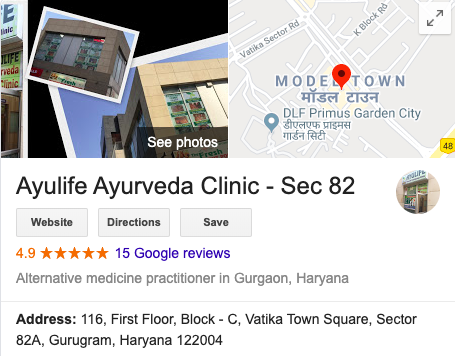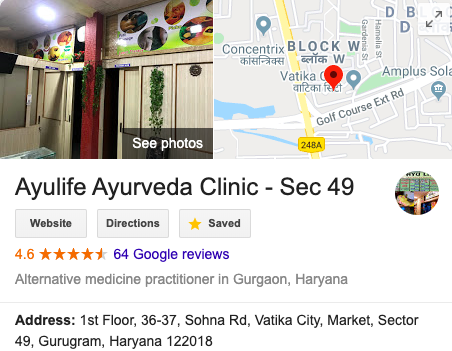How Ayurveda Treats
How Ayurveda Treats
Ayurveda is the most ancient therapy, all across the world. Its about 5000 years old, first time mentioned in the Rigveda. It literally means knowledge of life. The word Ayurveda is the combination of two words Ayu and Veda.
AYU means LIFE & VEDA means KNOWLEDGE
As per Rigveda, following are 2 basic principles of our constitution:
- PanchaMahabhut
- Tridoshas
5 Elements (PanchMahabhut) in Ayurveda
According to Ayurveda, each individual is structurally composed of Five basic elements of Universe and these elements relate to 5 basic senses as indicated :-
- Akash : For Hearing or ear and is represented by sound ( Sense)
- Air : It represents “Touch” sense is responsible for the respiratory system.
- Fire : It is responsible for digestion and perception/Eye Sight
- Water : It is responsible for fluid in the body or Taste through tongue.
- Earth : Represents Smell sense or Nose.
3 Humors (Tridoshas) in Ayurveda
The functional aspect of the body is governed by three biological humors. Each individual has unique characteristic of VPK which is decided at time of its birth. As per our great texts on Ayurveda – Ashtang Haridya.
वायु: पतं कफचेत यो दोषा: समासत: ॥ वकृताऽवकृता देहं नित ते वतयित च ।
vāyu: pittaṃ kaphaśceti trayo doṣā: samāsata: || vikṛtā’vikṛtā dehaṃ ghnanti te varttayanti ca |
Vayu/ Vata, Pitta and kapha are the three Doshas of the body. Perfect balance of three Doshas leads to health, imbalance in Tridosha leads to diseases.
- Vata —a combination of ether and air & Responsible for movement in the body
- Pitta—a combination of fire and water & Governs digestion.
- Kapha—a combination of water and earth & Responsible for body fluids
Types of Prakruti – Body Types
शु ातवथै: जमादौ वषेणैव वषकृमे: ॥ तैच त: कृतयो हनमयोतमा: पथकृ ् । समधात: समतास ु ु ेठा नया वदोषजा ॥
śukrārtavasthai: janmādau viṣeṇaiva viṣakṛme: || taiśca tisra: prakṛtayo hīnamadhyottamā: pṛthak | samadhātu: samastāsu śreṣṭhā nindyā dvidoṣajā ||
Like the poison is natural and inherent to poisonous insects, similarly, the Prakruti (body type) is inherent to humans. The body type is decided during conception, based on qualities of sperm and ovum.
The Tridosha are present all over the body, but their presence is especially seen in particular parts. If you divide the body into three parts, the top part upto chest is dominated by Kapha Dosha, between chest and umbilicus is dominated by Pitta, below umbilicus part is dominated by Vata.
Diagnosis in Ayurveda
Before treatment its important to make the right diagnosis by doctor. In Ayurveda diagnosis is carried based on the imbalance in the Tridoshas. To find the imbalanced doshas, Ayurveda Doctor needs to understand the “Prakriti” of patient and for that doctors ask certain set of queries from patient and then imbalanced dosha is found.
Find imbalanced Dosha in the body based on following symptoms:-
Reasons for imbalance in Doshas Vata Dosha : Late Night Sleeps, Stop Natural Urges like Urine, Stool etc , Mental Stress, Excessive Physical Exercise, absence of Ghee in Diet , Eat Cold & Preservative Food , Constipation,
- Pitta Dosha : Eating Spicy & hot food, Excessive Tea, Coffee, Constipation
- Kapha Dosha : Eat high calorie food like sugarcane juice or Extra Sugar Drinks, Excessive Sleep, Fried & Oily food, Cold drinks, Milks and Curd in Cold Weather, Bakery Products, Sedentary Lifestyle
These queries from Doctor help to understand the harmony in ‘Dosha’, the Tissue/Dhatu and the Impurity/Mala with each other. When all these are in balance the body will be healthy or we will be suffering from disease.
Due to these Symptoms following types of ailments are observed in patients :-
Symptoms /Ailments due to Imbalanced Doshas
- Vata Dosha : Bloating, Gastric, Body Stiffness, Joint Pains, Burping, Dry Skin, Constipation,
- Pitta Dosha : Acidity, Migraine, Burning in Chest, Sore Burps, Heat in the body, Excessive Sweating, Constipation, Skin Rashes
- Kapha Dosha : Sinusitis, Bronchitis, Heaviness in Body, Diabetics, High Cholesterol, Snoring, Lethargy, Excessive Sleep,
Treatment in Ayurveda
Broadly these are the major steps in Ayurveda treatment :-
- Nidaan Parivarjan :- Avoid Causative Factors for the origin of disease, Here the Ayurveda doctor will guide you to “Do and Donts” in your lifestyle. These could be changes in dietary lifestyle as patient is guided to avoid the “Causative factors” of the problem.
- Shaman Chikitsa : Herbal Medicines are given by doctor as symptomatic or palliative treatment to balance the Tridoshas by herbal medicines.
- Shodhan Chikitsa : Purification Procedure in which the imbalanced Dosha is eliminated from the body. Also called, Panchkarma Procedures. These are recommended to patient based on the imbalanced Doshas.
Panchakarma means “five procedures”. These five cleansing procedures remove accumulated waste materials in the body. Meant for both healthy and sick.
- Vamana – Induce vomiting with medicine
- Virechan – Cleaning the bowels with medicines
- Basti – Medicated oil Enema in Rectal Column
- Nasyam – Instilling Medication through Nose
- Leech Therapy – Blood Purification
Ayurveda comprehends Body, Mind and Spirit equally Hence Ayurveda treatment works on all.
Ayurveda - Holistic Treatment System
Ayurveda is holistic system of medicine as it offers all three treatment methods and not only cures the disease but also teaches the way of prevention i.e. teaches us the lifestyle to live healthy and free from disease.
- Symptomatic or Palliative treatment: In this treatment medicines are given to cure the symptoms usually its done at early stage of disorder or disease.
- Curative or Systemic Care: Treatment that works not only on the symptoms but overall system of body and thus treats the root cause.
- Preventive Care: Treatment where the patients are given advise before catching any disease.
About Vata Dosha & its characteristics
त ो लघु: शीत: खर: सू मचलोऽनल: ॥
tatra rūkṣo laghu: śīta: khara: sūkṣmaścalo’nila: ||
These are the parameters or qualities of Vata Dosha:-
- Rooksha – dryness
- Laghu – Lightness
- Sheeta – coldness
- Khara – roughness
- Sookshma – Short
- Chala – movement
Functions or Characteristics of Vata Dosha –
तंचलः उसाहोवास नवास चेटावेगवतनैः सयगया च धातनां ू अाणांपाटवेन चअनु गणात ृ अवकृतः
- Vatha Dosha regulates respiration process,
- Vata is responsible for all movements.
- Movement of blood in blood vessels, nutrients, air in lungs etc
- Locomotion movements of hands and legs etc.
- Regulates all activities of mind, speech.
- Initiation of natural urges like Tears, faeces, urination, sneezing, coughing, vomiting yawning.
- Maintenance of the Dhatus (tissues) in their normalcy and proper functioning of the sense organs.
Effects of increase or Decrease in Vata on body
वत ृ ुकुतेअनलः कायकायउनकामवकपानाशकृहान् बलनेियंशलापमदनताः
Vata, when increased produces
- Karshya – emaciation,
- Karshnya – black discoloration,
- Ushnakamitva – desire for hot things,
- Kampa – tremors
- Anaha – bloating, fullness, distention of the abdomen,
- Shakrut Graha – constipation,
- Bala bhramsha – loss of strength,
- Nidra bhramsha – loss of sleep
- Indriya bhramsha – loss of sensory functions,
- Pralapa – irrelevant speech,
- Bhrama – Delusion, Dizziness giddiness
- Deenata – timidity (peevishness).
Decreased Vata produces symptoms like –
लगंीणेअनलेअगय सदो अप भाषतेहतम ् संामोहतथा लेमवय ृ ु तामाशायसभवः
- Angasada – debility of the body,
- Alpa bhashite hitam – the person speaks very little
- Sanjna moha – loss of sensation (awareness) and of consciousness
- Occurrence of all the symptoms of increased Pitta or Kapha
About Pitta Dosha & its characteristics
पतं सनेह तीणोणं लघु वं सरं वम ।
् pittaṃ sasneha tīkṣṇoṣṇaṃ laghu visraṃ saraṃ dravam |
- Sasneha – slightly oily, unctuous,
- Teekshna – piercing, entering into deep tissues,
- Ushna – hotness,
- Laghu – lightness,
- Visram – bad smell,
- sara – having fluidity, movement,
- drava – liquidity are the qualities of Pitta.
Functions or Characteristics of Pitta Dosha –
पतंपयूमदशनैः ुतृ चभामेधाधीशौयतनु मादवैः
In its normal state, Pitta causes:
- Digestion and metabolism.
- Maintenance of body temperature,
- Maintains vision,
- Causes hunger,
- Thirst, appetite,
- Maintains skin complexion,
- Gives Intelligence, courage, valour
- Leads to softness (suppleness) of the body.
Effects of increase or Decrease in Pitta on body
Effects of increase of Pitta
पीतवमू नेवुतदाहापनताः ृ पतम ्
Pitta when increased produces
- Yellow discoloration of the faeces, urine, eyes, and skin;
- Excess of hunger and thirst,
- Feeling of burning sensation and very little sleep
Decreased Pitta causes
पते मदो अनलः शीतं भाहानः
- Mande anala – weakness of digestive activity,
- Shaitya – coldness
- Prabha hani – loss of luster (complexion)
About Kapha Dosha & its characteristics
िनध: शीतो गमद: लणो म ु न: िथर: कफ: ॥
ृ snigdha: śīto gururmanda: ślakṣṇo mṛtsna: sthira: kapha: ||
- Snigdhna – oily, unctuous, Sheeta – cold,
- Guru – heavy,
- Manda – mild, viscous,
- shlakshna – smooth, clear,
- Mrutsna – slimy, jely,
- sthira – stability, immobility
Functions or Characteristics of Kapha Dosha –
- Kapha confers stability, lubrication, compactness (firmness) of the joints,
- Kshama – It is the cause for mental capacity to withstand or withhold emotions, strains etc. It is also cause for forgiveness.
Effects of Increase or Decrease in Kapha on body
लेमा अिनसदनसेकालयगौरवम ् वैयशैयशलथागवं वासकासातनताः
Kapha, when increased produces
- Agnisadana – weak digestive activity,
- Praseka – excess salivation,
- Alasya – lassitude, laziness
- Gaurava – feeling of heaviness,
- Shvaithya – white discoloration,
- Shaithya – coldness,
- Shlathangatva – looseness of the body parts,
- Shwasa – dyspnoea, asthma, COPD
- Kasa – cough, cold
- Atinidrata – excess of sleep
Decrease of Kapha causes
कफे मः लेमाशयानां शू यवं वः शलथसिधता
- Bhrama – Delusion, Dizziness,
- Shunyatva – emptiness of the organs of Kapha,
- Shrudrava – tremors of the heart (palpitation)
- Shlatha sandhita – looseness of the joints
Getting relief from digestive problems is just 3 steps away!

Share your Details

Consult with Ayulife Doctor

Get a complete health Package
In Curative Treatment, following combination of therapies is used to treat the Knee Pain.
Reduce the Muscular stiffness and Increase the blood circulation in the joints.
Strengthening the muscles with Shamana ( Medicines)
Suggest changes in the lifestyle to reduce the formation of Ama/Toxins
By Panchkarma Therapies, we treat the Arthritis and following therapies are adapted
- Potli Massage
- Janu Basti
- Pichhu
- Abhyangam
- Basti










